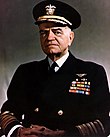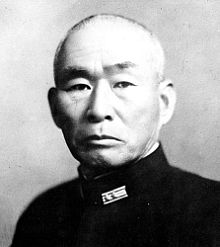
The Battle of Leyte Gulf consisted of four main separate engagements:
1 – Battle of the Sibuyan Sea
2 – Battle of Surigao Strait
3 – Battle of (or ‘off) Cape Engaño
4 – Battle off Samar.
On the map, Leyte Gulf is north of 2 and west of 4. The island of Leyte is west of the gulf. The battle was precipitated by a U.S. amphibious assault on the central Philippines Island of Leyte on Oct. 20.
By the time of the battle, Japan had fewer capital ships (aircraft carriers and battleships) left than the Allied forces had total aircraft carriers, underscoring the disparity in force strength at this point in the war. Regardless, the IJN mobilized nearly all of its remaining major naval vessels in an attempt to defeat the Allied invasion, but it was repulsed by the U.S. Navy’s Third Fleet under the command of Admiral William F. Halsey, Jr. and Seventh Fleet under the command of Admiral Thomas C. Kinkaid.


After the Battle of the Philippine Sea where the U.S. Navy destroyed three Japanese aircraft carriers, damaged other ships, and shot down approximately 600 Japanese aircraft, leaving the IJN with very little carrier-borne air power and few experienced pilots, the Japanese naval staff began designing a plan for the next battle named Sho-Go or Victory Operation. Four Sho-Go plans were developed depending on strike location. The plan for the attack on Leyte Gulf called for three naval forces to converge on the landing area. The Northern Force, under Vice Adm. Jisaburo Ozawa, would advance on Leyte from the north in an attempt to lure away the American 3rd Fleet. The main striking force, called the Center Force commanded by Vice Adm. Takeo Kurita, would come through the San Bernardino Strait to the east of Samar, then converge on the ships in Leyte Gulf. This force was composed of twenty-five warships, including the Yamato and the Musashi, the largest battleships afloat. The remaining ships, designated as the Southern Force were under the control of Vice Adm. Shoji Nishimura, who had at his command two older battleships, the Fuso and the Yamashiro; one heavy cruiser, and four destroyers. Vice Adm. Kiyohide Shima’s 2nd Striking Force, consisting of two heavy cruisers, one light cruiser, and seven destroyers, would join Nishimura.

On Oct. 22 at 8:00 am, the first elements of the First Diversionary Striking Force sailed from Brunei Bay. Vice Admiral Takeo Kurita was in the lead in Atago. He did not want to be aboard her. Before the battle, Kurita had wanted to transfer with his flag and staff to a superbattleship, either Yamato or Musashi, both of which had better communications gear than the Atago. But tradition ruled. Kurita was reminded by headquarters that the proper flagship for a striking fleet was a cruiser, to lead night torpedo attacks.
At the tip of Borneo, the great fleet divided. Admiral Nishimura, the southern arm of the Sho-Go pincer, turned east with his detachment of two battleships, a cruiser, and four destroyers and made for Surigao Strait, the southern entrance to Leyte Gulf. Kurita and the main body continued north on its slow and winding journey to the San Bernardino Strait. Kurita’s course on the first day took him just west of Palawan. The Palawan Passage was only about twenty to thirty miles wide, perfect for a submarine ambush.
His attack force, the strongest to be deployed, was the first to arrive in the Philippines. Two American submarines, the Darter and the Dace sighted the 1st Attack Force heading for the San Bernardino Strait on the morning of Oct. 23 and closed in for the kill.
Darter and Dace traveled on the surface at full power for several hours and gained a position ahead of Kurita’s formation, with the intention of making a submerged attack at first light. This attack was unusually successful. At 05:24, Darter fired a salvo of six torpedoes, at least four of which hit Kurita’s flagship, the heavy cruiser Atago. Ten minutes later, Darter made two hits on Atago‘s sister ship, Takao, with another spread of torpedoes. At 05:56, Dace made four torpedo hits on the heavy cruiser Maya. Atago and Maya quickly sank. As the Atago’s bow began to settle and she heeled over, Kurita announced, “This is it.” He turned to Captain Araki, the commanding officer of the Atago, and said simply, “It’s time to go.” He took off his shoes and was the first one over the side and into the water. He was rescued by the Japanese destroyer Kishinami, and then later transferred to the battleship Yamato. A total of 350 officers and men were lost on Atago, Kurita’s flagship. She was gone, sunk in nineteen minutes.
However, Darter and Dace could not stop the gigantic fleet, which included five battleships, among them two of the most powerful in the world, Musashi and Yamato. Switching Kurita’s flag to Yamato, the shaken but implacable Kurita headed for San Bernardino Strait.
Two heavy cruisers were badly damaged: Aoba, which was towed to Manila Bay and Takao, which made its way back to Brunei Bay, escorted by two destroyers, and was followed by the two submarines.
On October 24, as the submarines continued to shadow the damaged cruiser, Darter ran aground on the Bombay Shoal. All efforts to get her off failed. She was abandoned and her entire crew was rescued by Dace. Efforts to scuttle Darter failed over the course of the next week, including torpedoes from Dace and Rock (a Gato-class submarine named for the rock, a striped bass found in the Chesapeake Bay) and deck-gun shelling from Dace and later, Nautilus. After multiple hits from his 6-inch deck guns, the Nautilus commander determined on October 31 that the equipment on Darter was only good for scrap and left her there. The Japanese did not bother with the wreck. Takao retired to Singapore, being joined in January 1945 by Myōkō, as the Japanese deemed both crippled cruisers irreparable and left them moored in the harbor as floating anti-aircraft batteries.
To be continued . . .
Sources:
The Pacific War by William B. Hopkins
The Story of World War II by Donald L. Miller
Sea of Thunder by Evan Thomas
.jpg)
.jpg)